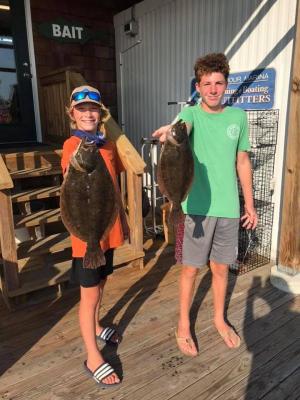Living in the Cape Region gives anglers an advantage not found in other places. We can fish from shore close to home and stand a pretty good chance of catching a decent number of fish.
One of the best places to fish is the Lewes-Rehoboth Canal, where flounder, blues, croaker and spot may be caught during the summer and into the fall. Just this past week, Logan Serpico caught a 20-inch flounder, and his friend Aiden Bowman had a 17-incher from the Lewes city dock on four-inch pearl Gulp! Roosevelt Inlet produced three flounder between 16.5 and 18 inches for Joe Allred and Nathan Heinze. They were casting speck rigs baited with pink Gulp!
Another good shore-based fishing spot is Broadkill Beach. There is plenty of access from the parking lot at the south end of town, and kings along with some keeper trout have been caught there all summer. Bloodworms or FishBite bloodworms make the best bait.
The most popular fishing location in Delaware is the fishing pier at Cape Henlopen State Park. Spot remain the main draw here, but last week a 5.5-pound flounder was caught from the boards. Once again, bloodworms or FishBite bloodworms will work for the spot while live minnows or Gulp! swimming mullet fished close to the pilings have accounted for most of the flounder. Due to the shallow water, the pier only fishes well on high tides.
The entire Delaware Seashore State Park system from Cape Henlopen to Fenwick Island is open to surf fishing. There are parking lots where anglers may walk to the beach, or you can drive on if you have the proper equipment and a Delaware surf-fishing permit. The 17,000-permit quota for 2019 has been reached, so if you don’t have one you must wait until next year to get one.
This has been a very good summer for surf fishermen. I personally have not been skunked on any of my trips to the beach and currently have a nice supply of kings in my freezer. Some surf fishermen have encountered Spanish mackerel and pompano. I have not been that lucky, but have not given up hope.
I have been using FishBites almost exclusively. They last much longer on the hook than bloodworms or sand fleas; they don’t get the bait board dirty; they don’t attract flies, and when the day is over, they go back in the bag and are ready for the next trip. So far, they seem to work at least as well as, if not better than, the real thing.
Indian River Inlet has loads of access with sidewalks all around both sides. The more adventurous can walk out on the rock jetties, but old bones break easily and heal slowly, so I will stay on the sidewalk. Right now, blues run through on incoming water, and sheepshead have been caught on sand fleas fished tight to the rocks. Rockfish are taken at night on eels, sand fleas or Tsunami shads.
There are a few other locations for shore-bound anglers. Oyster Rocks at the end of Oyster Rocks Road provides access to the Broadkill River. There is a path from the parking lot at the south end of Broadkill Beach that also leads to the Broadkill River. Depending on the time of year, you can catch blues, flounder, croaker, spot and white perch from either of these two spots.
There is a good fishing pier at the head of the Broadkill River in Milton, but due to the shallow water, it is best to fish here at high tide. The public park in town also allows fishing from the bank, and I have caught bass, and white and yellow perch from there.
As you can see, all you need is a rod, reel and some sort of bait to go fishing close to home. No boat required.
Fishing report
The best news this week is an improved flounder bite. The Katydid finally brought in a boat limit from ocean structure, and several private boats did very well at B Buoy and the Old Grounds. We saw improved flounder catches from the Lewes-Rehoboth Canal, and the Indian River and Rehoboth bays.
Kings, croaker and spot continue to come from the surf on bloodworms or FishBite bloodworms. Blues and Spanish mackerel show up here and there within casting range of metal lures. Fenwick Shoal continues to produce blues and Spanish on trolled metal lures.
Cobia have been caught from the Cape May Rips where Steve Redden Jr. and Jeff Waxman had two Sunday.
Offshore has seen an increase in white and blue marlin. The Sea Flame released 14 whites Sunday.
























































